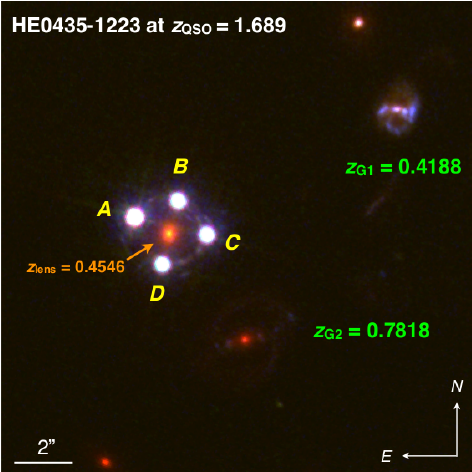Quasar Microlensing
Quasar HE0435-1223
The quasar HE0435-1223 is a normal quasar. With a measured spectral redshift of about 1.7, this quasar is about 6.4 billion light years from Earth. What makes it special is that along the line of sight to this quasar, there is an intervening galaxy at redshift 0.45, about 4.8 billion light years from Earth. According to Einstein's General Relativity, mass causes a bending of spacetime. The gravitational mass of the intervening galaxy bends spacetime, so that the light rays from the background quasar also get bent on their way here, making it appear to us as if there are 4 quasars instead of one.
Below is an image of the microlensed quasar HE0435-1223 taken by the Hubble space telescope. It shows four point-like lensed images marked ABCD of the background blue quasar, which surround the intervening redder fuzzier-looking galaxy. Two other galaxies are shown in the image. They are too far away from the quasar sightline to cause any significant gravitational lensing. However, the absorption signatures of their extended gaseous envelopes may be seen imposed on the quasar spectra. All three galaxies in the image are labeled with their redshifts. All three are much closer to Earth than the quasar.

We know that it's actually just one quasar, because the spectra are virtually identical. The only differences we see between spectra of the 4 quasar images are caused by variability in the quasar, and the fact that the four light paths have slightly different lengths.
All quasars vary, and this one is no exception. Astronomers have compared the light curves from the 4 different quasar images, and found them to be nearly identical, once time lags between them are taken into account. Those time lags allow astronomers to determine the different light path lengths to the quasar, and they use that to build gravitational models of the intervening galaxy. In addition, microlensing by stars in the intervening lensing galaxy can cause differences between the light curves.
Light curves from Bonvin, V. et al. 2017, MNRAS, 465, 4914 (via link)
Spectra from Sluse, D., Hutsemekers, D., Courbin, F., et al. 2012, VizieR Online Data Catalog (link)
Image from Chen, H-W 2014, 438, 1435

